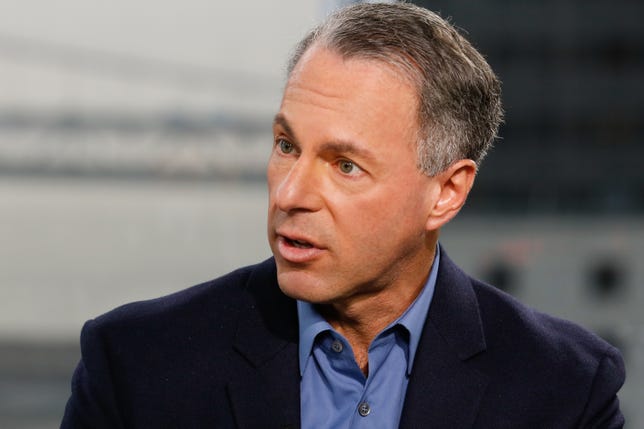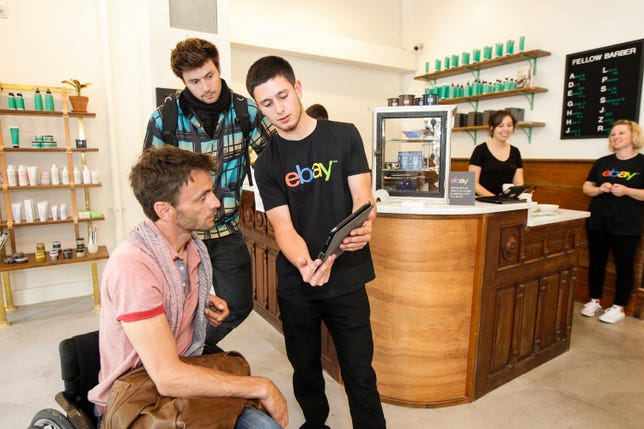
Courtesy of Larry Phillips
Larry Phillips’ business on eBay is plummeting and he doesn’t know why.
The owner of 4StampSales.com has been selling rare and collectible stamps online since 1999, turning the side business into his main job in 2005 after he took an early retirement as an executive for banking company MBNA. He now pulls in annual sales in the “mid-six figures” and has two part-time employees helping him list and ship thousands of items, from US stamps commemorating the 1994 World Cup to Botswana stamps of birds.
But a few years ago, sales on eBay — a major part of his revenue — started to sink and haven’t revived. A year and a half ago, Amazon asked him to start offering his stamps on its website. He said yes, and the decision helped reinvigorate his business.
“One of the reasons why I was interested when Amazon recruited me was because my eBay business was tanking,” Phillips, of Wilmington, Delaware, said, blaming eBay for not giving him enough data to figure out why his sales soured.
The troubles at 4StampSales highlight several of eBay’s larger problems. Many mom-and-pop sellers complain that eBay neglected them as it pursued big-name retailers such as Target and Best Buy to list on its site, trying to become more like an online mall and less an Internet flea market. Smaller sellers responded by shifting business toward larger rival Amazon or startup e-retailers like Poshmark and Twice. The strategy also didn’t seem to impress consumers, many of whom continued to find eBay’s site hard to navigate, regardless of what was sold there.


CNBC
“They’ve really disenfranchised a lot of people out there,” said Scot Wingo, executive chairman for ChannelAdvisor, which provides e-commerce services for sellers on eBay and Amazon. “eBay has a long history of messing things up.”
The numbers illustrate eBay’s struggles. In 2014, worldwide online retail sales grew 22 percent, according to eMarketer, but the company’s marketplace revenue was up just 6 percent to $8.8 billion.
There will be a lot more attention paid to these troubles after eBay on Friday spins off its fast-growing PayPal digital payments unit, leaving the 20-year-old e-commerce pioneer to fend for itself as it works on a turnaround. The two businesses decided to separate following more than 10 years together after activist investor Carl Icahn pressured them to break up to so PayPal could focus on its own growing business. PayPal and eBay said a split would help narrow their respective strategies, though their smaller size make them both more vulnerable to a potential acquisition.
What’s at stake for customers and small retailers is that if eBay fails to make needed fixes, it will weaken one of the few major online competitors to Amazon, the biggest e-commerce company worldwide by market share. That, in turn, could reduce choices and increase prices for consumers.
Devin Wenig, eBay’s incoming CEO and the company’s current marketplaces president, has outlined plans to refocus the San Jose, California-based retailer on its roots, getting back to its core customers and mom-and-pop sellers that have traditionally come to eBay to exchange unique and hard-to-find items. He also wants to encourage more consumers to try selling on eBay, hoping more people will again start listing items in their attics, garages and closets, which eBay claims have an estimated value in the US of $100 billion. Many of those amateur sellers have switched to Craigslist or Facebook groups to avoid eBay’s higher fees. A data breach last May almost permanently drove away many of these infrequent users.
Bringing in a fresh crop of sellers could give the marketplace’s community a helpful boost and spark more interest in browsing the site, thanks to an increase in selection of rare and random goods and stronger competition pushing down prices for buyers.
“One part we want to continue to grow and invest in is insights and the data we provide back to sellers to help inform them,” Heather Friedland, eBay’s vice president of local and seller experience, said when asked about some of the problems 4StampSales is facing. “We’re really listening to our sellers.”
Wenig was not available to comment for this story, an eBay representative said.
PayPal’s chance to cash in
While eBay struggles to build itself back up after the split, PayPal will face a different set of challenges under the helm of its incoming leader, Dan Schulman, a former American Express and AT&T executive.


Scott Olson/Getty Images
PayPal, which eBay purchased in 2002 for $1.5 billion, enjoys huge growth as online and mobile payments take off. Compared with eBay’s marketplace sales growth of 6 percent last year, PayPal’s revenue jumped 19 percent, to $7.9 billion. That faster growth means PayPal, for now a unit of its parent, will likely become the larger company by market value after the break-up. Marking that change, on Tuesday night, S&P Dow Jones Indices said PayPal will join the S&P 100 — an index of some of the largest US companies. The company it replaces: eBay.
The divorce will let PayPal explore expansion in the $22.5 trillion worldwide retail market, where e-commerce is a small, but growing, sliver of sales. Thanks to an operating agreement, PayPal will keep its critical position as eBay’s main payments service for five years, allowing PayPal to hold onto its biggest customer even while shopping around for other dates. On top of that, PayPal has become one of the most trusted and recognizable names in digital payments, according to surveys by Wedbush Securities, giving it a big advantage over rivals.
But PayPal is facing more competition, as tech giants Apple, Google and Amazon, payments networks Visa and Mastercard, and a slew of startups including Square are building up their own digital payments services and trying to catch on to a huge shift in how consumers spend their money and merchants take payments. PayPal will have to run even faster if it hopes to maintain its leading position.
“There’s a proliferation of different choices that consumers have, whether its Apple Pay or Visa wallets,” said Hill Ferguson, global head of PayPal’s consumer business. “We continue to move the ball forward to make sure consumers know that there’s a good reason to choose PayPal when they have that choice.”
RELATED STORIES
- eBay sales, profit rise as PayPal expects to sail off in third quarter
- eBay makes mobile push with Apple Watch app
- Pressure is on: eBay needs to deliver after PayPal’s spin-off
- eBay cutting jobs ahead of PayPal split
The eBay-PayPal operating agreement means eBay customers shouldn’t expect any significant changes to its payments options in the coming years. However, a big shift will be PayPal’s new freedom to partner with many more companies, including perhaps eBay’s main competitors Amazon and Chinese e-commerce giant Alibaba. That would help PayPal reduce its heavy dependence on eBay, which today makes up about 30 percent of its payment volume, and give PayPal’s more than 165 million active users more place to pay utilizing their accounts.
“We would love to work with Amazon,” Ferguson said, “and we’re talking to anyone and everyone in the industry, not just merchants, but large technology companies, large mobile operators, large financial institutions, literally every major player in the ecosystem.”
An Amazon representative declined to comment for this story.
Hopes for an eBay turnaround
Despite eBay’s problems, it continues to have sizable advantages that make a resurgence possible. Its business is highly profitable, thanks to its model of simply offering a platform for others to buy and sell items and avoiding the costs of owning inventory, warehouses and distribution networks. The marketplace’s operating profit margin was 38 percent last year — meaning the business pocketed 38 cents in profit per $1 in revenue — compared with PayPal’s 23 percent margins.
Amazon, meanwhile, continues to rapidly grow its revenue and expenses, resulting in an operating profit margin last year of less than 1 percent.
eBay also has maintained a massive following, with 25 million sellers offering about 800 million listings worldwide to more than 157 million active buyers. With a market value of about $76 billion before the split, it’s the third largest online retailer globally, after Amazon and Alibaba, though its market share remains half that of Amazon’s, according Euromonitor.
“There’s no doubt that eBay’s got an ability to turn around. They’ve still got this massive loyal base,” said Kevin North, CEO of Terapeak, which provides products data for eBay and Amazon merchants. “There’s a group of loyalists that want eBay to succeed.”


Kimberly White/Getty Images
He said eBay could win back sellers that have shifted to Amazon by providing more expert advice and resources on specific segments, such as antique or clothing sales. On the consumer side, eBay already is working on making it easier for people to jump into selling on its site, offering new services like eBay Valet, which lets people mail away items to more experienced sellers who then photograph and list for them. The company is also embarking on a multiyear project to better organize its millions of varied listings — from socks to cars to antique hand-painted vases — so it will be easier to find items.
North added that there’s “a lot of optimism” from sellers that his company works with over Wenig’s plans for change.
“They should do just fine after the spinoff,” said Wedbush analyst Gil Luria. “They just won’t be growing as fast as they did with PayPal.”
Phillips, the owner of 4StampSales, isn’t all that convinced by Wenig’s plans and said he remains in “a holding pattern with eBay,” not decreasing his listings on the site but not adding much to his storefront there either.
“I love the words, I love what he said,” Phillips said about Wenig’s vision of refocusing on small sellers and treasure-seeking buyers. “I’m not sure that’s what’s going to happen.”




